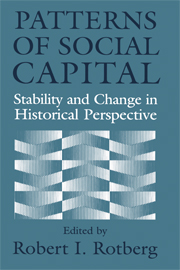Book contents
- Frontmatter
- Contents
- Introduction Social Capital and Political Culture in Africa, America, Australasia, and Europe
- Articles
- Civic Traditions in Premodern Italy
- The Sources of Civil Society in Italy
- Finding Social Capital: The French Revolution in Italy
- Social Capital in the Early Industrial Revolution
- The Diversity of Social Capital in English Communities, 1300–1640 (with a Glance at Modern Nigeria)
- Social and Cultural Capital in Colonial British America: A Case Study
- The Growth of Voluntary Associations in America, 1840–1940
- Civil Society as Democratic Practice: North American Cities during the Nineteenth Century
- Securing Political Returns to Social Capital: Women's Associations in the United States, 1880s–1920s
- Second-Generation Civic America: Education, Citizenship, and the Children of Immigrants
- Human Capital and Social Capital: The Rise of Secondary Schooling in America, 1910–1940
- From Local to National Political Cultures: Social Capital and Civic Organization in the Great Plains
Human Capital and Social Capital: The Rise of Secondary Schooling in America, 1910–1940
Published online by Cambridge University Press: 12 April 2010
- Frontmatter
- Contents
- Introduction Social Capital and Political Culture in Africa, America, Australasia, and Europe
- Articles
- Civic Traditions in Premodern Italy
- The Sources of Civil Society in Italy
- Finding Social Capital: The French Revolution in Italy
- Social Capital in the Early Industrial Revolution
- The Diversity of Social Capital in English Communities, 1300–1640 (with a Glance at Modern Nigeria)
- Social and Cultural Capital in Colonial British America: A Case Study
- The Growth of Voluntary Associations in America, 1840–1940
- Civil Society as Democratic Practice: North American Cities during the Nineteenth Century
- Securing Political Returns to Social Capital: Women's Associations in the United States, 1880s–1920s
- Second-Generation Civic America: Education, Citizenship, and the Children of Immigrants
- Human Capital and Social Capital: The Rise of Secondary Schooling in America, 1910–1940
- From Local to National Political Cultures: Social Capital and Civic Organization in the Great Plains
Summary
The landlord who lives in town has only a financial interest and must be reached from the financial side. He may well be reminded that when he offers his farm for sale it will be to his advantage to advertise, “free transportation to a good graded school.”
Those who have no children to attend school are often indifferent as to school privileges, but they more than others should be interested in securing to the children of the whole community the best educational advantages possible. They may be secure and independent at present, but if they live out their years with no children to depend upon in old age, they must of necessity rely upon someone, they know not whom, who is today in the public schools. Their only safeguard lies in giving the best advantages possible to all.
Iowa Biennial Report, 1912/13, on the campaign for consolidated school districtsThe United States led all other nations in the development of universal and publicly funded secondary school education, and much of the growth occurred from 1910 to 1940. The focus of this article is on why the “high school movement” occurred in America generally and why it occurred so e arly and swiftly in America's heartland—a region we dub the “education belt.” Since Iowa was at the center of this belt, we use information from the unique Census of Iowa for 1915 at both the county and individual level to explore the factors that propelled states like Iowa to embrace so expensive a public good as secondary school education.
- Type
- Chapter
- Information
- Patterns of Social CapitalStability and Change in Historical Perspective, pp. 295 - 336Publisher: Cambridge University PressPrint publication year: 2000
- 2
- Cited by



